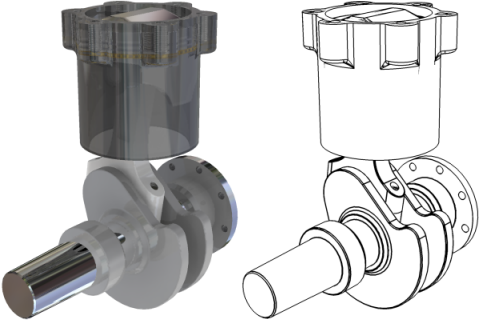Rendering an animation outputs the animation according to the settings you specify in the render dialog box. There are three tabs in the dialog box that provide settings based on the selections you make on the General tab. We recomend using the Preview Render option to confirm the camera shows the animation in the way you want.
Before you render an animation, must make sure that no productions are active. In the browser, expand the production folder and if a production is active, it will have a check mark next to it, right-click and deactivate it. Active productions take precedence over active animations at render time.
Specify rendering settings for an animation.On the ribbon, click
Render tab
 Render panel
Render panel
 Render Animation
Render Animation
![]() .
.
- On the General tab, specify:
- Height and Width
- Camera
- Lighting and Scene Style
- Render type - Shaded or Illustration
 Note: When rendering an animation, not a production, you can only record one camera at a time. If you want to use multiple cameras when rendering the animation you must use Video Producer or other video editing software.
Note: When rendering an animation, not a production, you can only record one camera at a time. If you want to use multiple cameras when rendering the animation you must use Video Producer or other video editing software. - On the Output tab, specify: whether to render all or part of the animation. You may choose to render the animation in reverse. Provide the output file name and type (.avi, .wmv, or static images) and the frame rate. Use Preview render to quickly see the results. Preview render uses the scene or IBL lighting from the modeling environment instead of Studio lighting.
- File type and name the animation will be saved to. If you select WMV as an output type, use the Custom option for Network Bandwidth with a value of 700 or higher.
- Full animation or Time range. Use a time range to produce segments of the animation. Specify the range in seconds or frames. To specify frames, use the letter ‘f’ after the value, for example, 24f to 124f.
- Antialiasing level. The higher the level, the more time required to produce the output.
- Format. You can specify video output or image output which results in each frame being output as an image. You would compile these in a third-party editor to produce the animation.
- Preview: No Render. Use this option to preview the output in a file. Lighting and scene information is not rendered.
- Frame Rate. As a gauge, typical television and movie frame rates are between 24 and 30 fps.
Note: Preview Render records the animation using model scene elements such as lighting, shadows, and reflection. - On the Style tab, when rendering the final version, select True Reflection for realistic output. If producing Illustration output, this tab will present several settings allowing control over the illustration output.